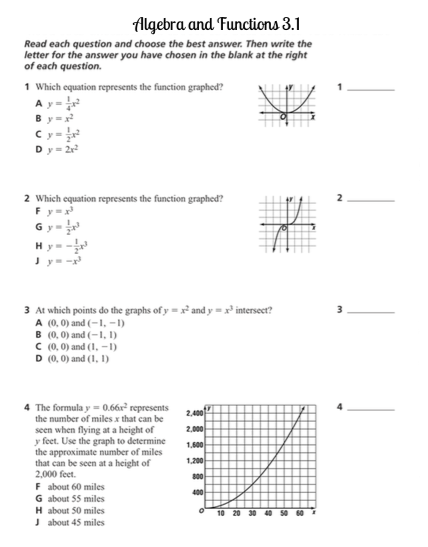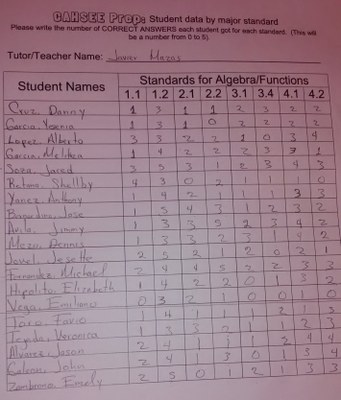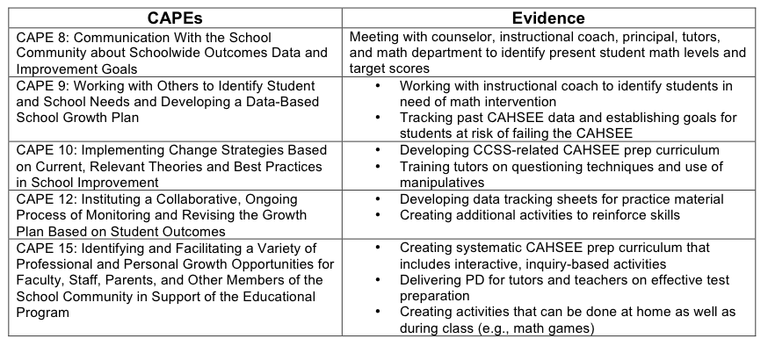Fieldwork Project: Developing a CAHSEE Math Prep Tutoring Program at STEM Academy of Hollywood
 Part of my job as a Common Core Facilitator is to work with schools to improve the math program. STEM Academy of Hollywood, a pilot school that is known for Project-Based Learning, is one of the schools I serve. As soon as I began my position in November, the principal talked to me about helping to organize a CAHSEE tutoring program. The school had allocated funds to pay three college students to work for four hours each week to provide CAHSEE math tutoring. For this project, I met several times with the principal, instructional coach, and counselor to identify students who would benefit from tutoring, schedule tutoring times, and think about ways to review material that go beyond traditional "drill and kill" multiple-choice practice. Then, I met with the tutors to talk with them about their roles and to give them some suggestions for tutoring. I designed pre- assessments and a data collection system so that the tutors could identify concepts that were particularly difficult for students, and then used that data to create inquiry-based, collaborative activities to reinforce these concepts.
Part of my job as a Common Core Facilitator is to work with schools to improve the math program. STEM Academy of Hollywood, a pilot school that is known for Project-Based Learning, is one of the schools I serve. As soon as I began my position in November, the principal talked to me about helping to organize a CAHSEE tutoring program. The school had allocated funds to pay three college students to work for four hours each week to provide CAHSEE math tutoring. For this project, I met several times with the principal, instructional coach, and counselor to identify students who would benefit from tutoring, schedule tutoring times, and think about ways to review material that go beyond traditional "drill and kill" multiple-choice practice. Then, I met with the tutors to talk with them about their roles and to give them some suggestions for tutoring. I designed pre- assessments and a data collection system so that the tutors could identify concepts that were particularly difficult for students, and then used that data to create inquiry-based, collaborative activities to reinforce these concepts.
When I began working with the STEM team, I learned that the students had taken a pre-assessment and that their scores were recorded on a spreadsheet. However, the spreadsheet only gave baseline scores for the math section, and were not desegregated by standard (see the full spreadsheet here). In order to identify the concepts that were most difficult for students, I consulted with the math department during common planning time. The teachers agreed that Algebra and Functions, Algebra 1, and Geometry tended to be the most difficult strands in the CAHSEE. The CAHSEE consists of five strands that each encompass about ten specific standards. Based on this information, I used several different sources for CAHSEE prep questions and created a one-page mini-quiz for each standard of the three teacher-identified strands. Below is an example:

To see a full set of mini-quizzes for the Algebra and Functions strand, click here.
Next, I met with the tutors. I asked them about their previous experience working with high school students. Two tutors had no previous experience, and another used to work for an after-school program, but had more experience supervising athletics than tutoring. I gave them examples of math problems that had been worked incorrectly, and asked them to role-play how they would help students to see their errors. I focused on questioning techniques: they should try to avoid automatically telling a student whether she is "right" or "wrong," but rather ask the students to discuss the problem in a small group. We talked about pointing out particular parts of the problem and asking students to explain how they arrived at their answers. The tutors were excited to work with the students, and told me that the session was helpful.
 I then outlined my plan for the tutoring sessions. I showed the tutors the mini-quizzes I had created, and suggested that they administer one or two mini-quizzes to the students each day. The students could score the results together and ask questions about problems they didn't understand after their scores were recorded. I provided the tutors with data collection sheets. To see the original data collection template, click here. When the tutors had administered mini-quizzes for the entire strand, they took pictures of the completed data collection sheets and emailed them to me (see image at right). I then analyzed the student scores and developed follow-up activities that the tutors could use to help students understand the concepts with which they struggled. For these activities, I created card sorts, collaborative mini-projects, and games. I also developed practice sheets that the students could work on during the tutoring session or at home to explore the most problematic standards in greater depth. An example of one of these take-home practice sheets appears below.
I then outlined my plan for the tutoring sessions. I showed the tutors the mini-quizzes I had created, and suggested that they administer one or two mini-quizzes to the students each day. The students could score the results together and ask questions about problems they didn't understand after their scores were recorded. I provided the tutors with data collection sheets. To see the original data collection template, click here. When the tutors had administered mini-quizzes for the entire strand, they took pictures of the completed data collection sheets and emailed them to me (see image at right). I then analyzed the student scores and developed follow-up activities that the tutors could use to help students understand the concepts with which they struggled. For these activities, I created card sorts, collaborative mini-projects, and games. I also developed practice sheets that the students could work on during the tutoring session or at home to explore the most problematic standards in greater depth. An example of one of these take-home practice sheets appears below.


These practice sheets allow for more in-depth discussion and thinking than multiple-choice practice alone. As the tutoring sessions went on throughout the year, some tutors used the resources I created on an as-needed basis, differentiating instruction to ensure that each student received the help she/he needed. Also, as I continued to check in with the tutors, I showed them additional online resources and manipulatives like algebra tiles that may be helpful to them during their tutoring sessions.
After the students took the CAHSEE, the tutors and I asked them how they thought it went. Most students had positive things to say about the math section, and the feeling was confident overall. The leadership team at STEM was nervous, however, because the data from previous years was already above the District average, with an 83% pass rate for math, and they wanted to ensure that their pass rate did not decline. When the CAHSEE results came in, the team was happy to find that the math pass rate had reached 90%, the highest in school history. Click here to view the STEM newsletter that has a complete breakdown of the 2014-15 CAHSEE data.
Overall, I the CAHSEE tutoring program ran smoothly and yielded great results. The principal was pleased that we were able to lay the foundation for a program that could be replicated in future years. If I were to continue to work on the CAHSEE project, I would like to add new activities and improve upon some that I created, but am not entirely happy with. I would also have liked to be able to spend more time with the tutors, both during tutoring sessions and during their breaks, to check in with them more frequently about what was working and what needed improvement. The only difficult issue that arose during this process was attendance: some students failed to attend tutoring, and many came for tutoring inconsistently. Were I to repeat this process, I would spend more time with the leadership team brainstorming ways in which we could increase attendance.
This project covered several California Administrator Performance Expectations. Please refer to the chart below to see specific CAPEs and the ways in which this project addressed them.


